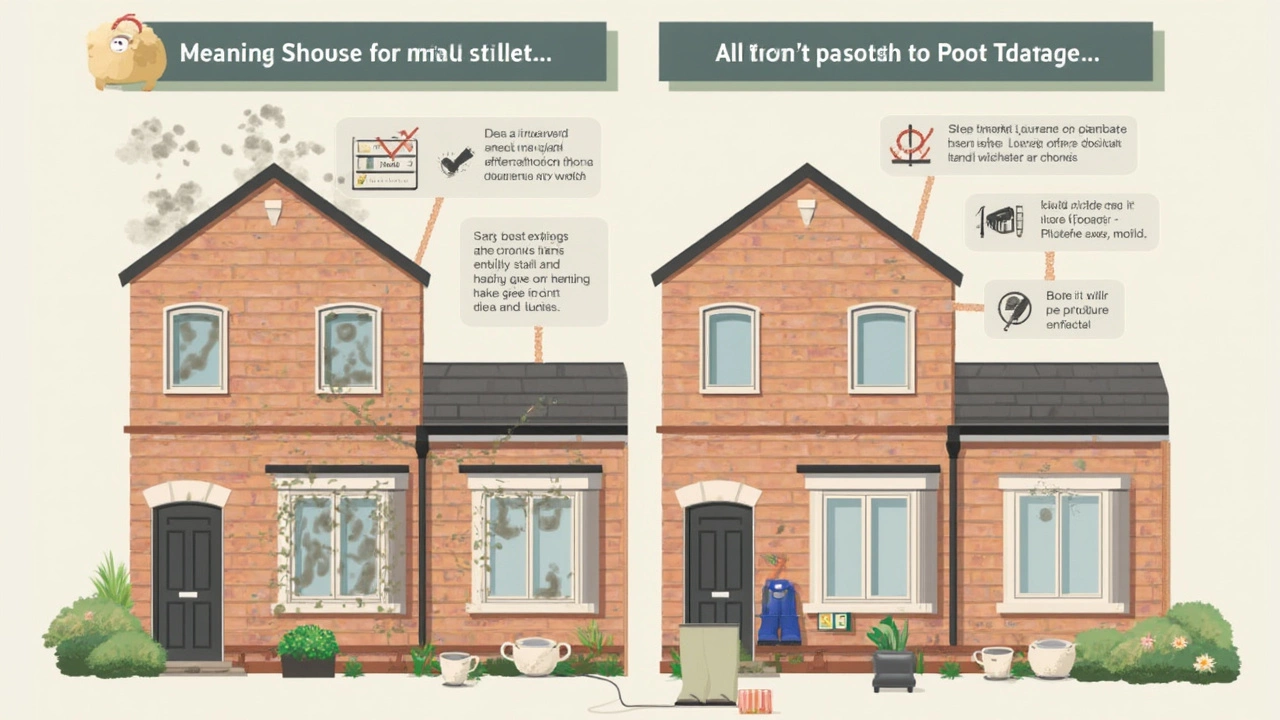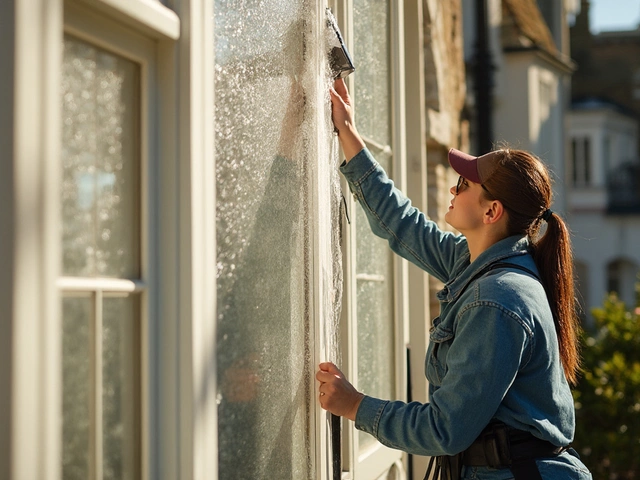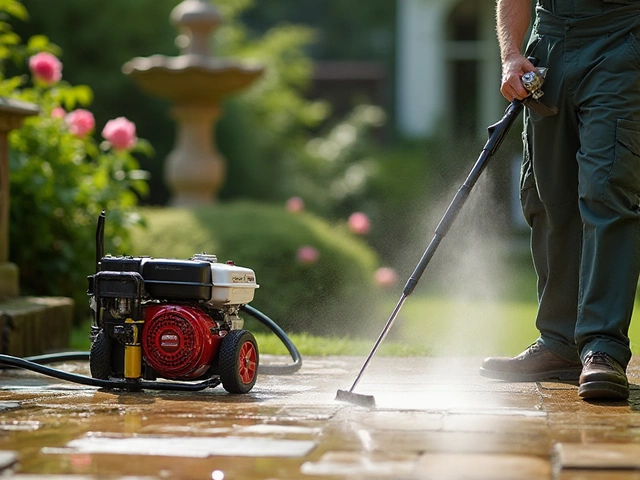If you’ve ever battled those stubborn black or green spots on your deck, siding, or driveway, you know how mold can take over fast. Mold isn’t just about looks—it can be slippery, damage surfaces, and even mess with allergies. People always wonder, can a pressure washer really blast it away?
The short answer: yes, but there’s a bit more to it. Pressure washers can strip mold right off loads of outdoor surfaces, but you need to know what you’re doing. Ever hit your drive with a sprayer just to watch the mildew creep back a few weeks later? That's because just blasting away what you see doesn’t always get the roots hiding underneath. Mold is sneaky. It gets into cracks, pores, and grooves, especially on wood and concrete.
Here’s where know-how comes in handy. The right pressure setting matters a lot—go too hard, and you might actually damage your deck or break your fence panels. And while it’s tempting to just blast and forget, you’ll want to tackle the real trouble beneath the surface for long-term results. My first time cleaning the patio, I learned the hard way that power isn’t everything. If you play it right though, pressure washing is one of the most satisfying ways to get your home looking fresh again.
- Why Mold Shows Up and Sticks Around
- How Pressure Washing Tackles Mold
- When to Use Chemicals (and When Not To)
- Staying Safe and Preventing Mold’s Return
- Real-World Results and Extra Tips
Why Mold Shows Up and Sticks Around
Mold isn’t just annoying—it’s a super survivor. A mix of shade, moisture, and the right surface is all it takes for mold to show up. Rain, humid weather, and even sprinklers are usually the big reasons it finds a spot to grow, especially outdoors. Driveways, patios, decks, and house siding are all easy targets because they trap water and don’t dry out as fast as you’d hope.
Mold spores are in the air all the time. If they land somewhere damp that doesn’t get a lot of sunlight, they settle in and start multiplying fast. Mold eats anything organic, like wood, dust, dirt, and even tiny bits of leaves or pollen stuck to your siding or concrete. That’s why you’ll spot that green fuzz more quickly right after the rainy season or if you’ve got lots of trees around your place.
It gets worse if you don’t clean up often. Mold can dig its roots (called hyphae) into porous surfaces—think old wood or cracked concrete—making it super hard to get rid of by just rinsing it off. And don’t forget, mold thrives between 60 and 80 degrees Fahrenheit, which is basically spring and fall in most states. So if your area sees a lot of wet weather or shady spots, mold loves it.
Want a quick look at how mold sticks around? Check these out:
| Factor | How It Helps Mold Grow |
|---|---|
| Humidity | Mold grows best over 60% humidity |
| No Sunlight | Shady spots barely dry, so spores thrive |
| Poor Drainage | Puddles give mold a constant water source |
| Porous Surfaces | Mold’s roots dig in deep—hard to wash out |
So, if you see mold hanging around on your siding or deck year after year, it’s probably because these conditions stick around too. Tackling these root causes means less work down the road and makes any pressure washer job way more effective.
How Pressure Washing Tackles Mold
Here’s what actually happens when you fire up a pressure washer on mold. The blast of water forces mold off surfaces in a way regular scrubbing can’t compete with. Mold is tough, and its spores burrow into tiny cracks on things like concrete, brick, and wood. A pressure washer sends water at 1,500 to 3,000 psi (pounds per square inch)—that’s way more powerful than a garden hose, sometimes strong enough to take gum off sidewalks. That's why it can shift even stubborn patches of old mold or mildew.
But not every surface can take the same beating. If you go full blast on old wood or paint, you could do more harm than good. Most pros recommend different settings for specific surfaces:
- Wood: 500-1,200 psi (start low to avoid splintering or gouging)
- Vinyl siding: 1,300-1,600 psi
- Concrete and brick: up to 3,000 psi
If you’re aiming for a deep clean, try these steps to get the job done right:
- Sweep or brush loose debris off before washing.
- Set your washer to the right pressure for the surface.
- Hold the nozzle a good 12-18 inches away to avoid damaging what you’re cleaning.
- Work in small sections, moving in even sweeps.
- If mold hangs on, use a gentle back-and-forth motion instead of staying in one spot.
One study from a cleaning industry group found that pressure washing can remove up to 99% of visible mold from outdoor wood in a single session, but deep-set mold might start reappearing in 2-3 months if left untreated afterward. Here’s how the numbers looked in their trials:
| Surface Type | Pressure Used (psi) | Visible Mold Removed | Mold Return (in 3 months) |
|---|---|---|---|
| Treated Wood Deck | 1,200 | 98% | 20% |
| Vinyl Siding | 1,500 | 99% | 10% |
| Concrete Driveway | 2,500 | 99% | 15% |
The takeaway? Pressure washing blasts away most mold fast, but it doesn’t always kill the tiny spores. That’s why it sometimes comes back. For really stubborn or hidden mold, pairing pressure washing with a targeted cleaner gets you better, longer-lasting results.

When to Use Chemicals (and When Not To)
So, you’ve got the mold. You’ve got the pressure washer. Now you’re probably thinking, “Do I really need to add chemicals to this mix?” Here’s the deal: sometimes water alone isn’t enough to beat mold for the long haul. Mold isn’t just a surface problem. It can live deep down, especially in shady, damp spots where your regular rinse won’t reach.
Best time to break out the cleaners? When you’re dealing with stubborn patches that keep coming back, or if you notice mildew smell hanging around days after washing. The U.S. Environmental Protection Agency recommends using cleaners with mold-killing power if visual mold or a musty smell remains after washing with water. Basically, if it smells funky, it’s time for chemicals.
“On hard surfaces, mold can usually be removed by cleaning with soap and water, or a bleach solution when needed.” — Centers for Disease Control and Prevention
Some homeowners go straight for bleach, but that’s not always the safest or best option, especially if you’ve got plants or pets around. Luckily, there are mold fighters made for outdoor use—look for products labeled ‘mold and mildew remover’ at the hardware store. Always check if they’re safe for your surface (vinyl, wood, or concrete can react differently).
- Pressure washer detergent: Made to run through the washer, these are low in suds and work well on siding and decks.
- Oxygen bleach: Gentler than regular bleach, it won’t trash your plants but still packs a punch against mold.
- Vinegar: Safe and cheap, but less effective on deep mold—works for light touch-up jobs.
If you’re treating wood, skip the harsh stuff like straight bleach. It’s too rough and it can strip color or even weaken the surface. On the other hand, concrete and brick are tough, so they can usually handle stronger solutions.
But let’s be real—not every mold issue needs chemicals. If you’re cleaning sealed surfaces or just seeing a light dusting, water at the right pressure can get the job done. Chemicals should also stay on the shelf if you’re near the veggie garden or have pets and little kids playing nearby. If in doubt, test a small hidden spot first.
| Surface Type | Recommended Cleaning Agent | Chemicals Needed? |
|---|---|---|
| Wood Decking | Oxygen bleach, pressure washer detergent | Sometimes |
| Concrete Driveway | Bleach solution, specialty cleaner | Usually |
| Vinyl Siding | Pressure washer detergent | Sometimes |
| Sealed Surfaces | Water alone | Rarely |
One last tip: never mix chemicals or try shortcuts like using dish soap in the pressure washer. Always read the label and follow instructions. If you’re ever unsure, stick to water and elbow grease—or call in the pros. Your surfaces (and your lungs) will thank you.
Staying Safe and Preventing Mold’s Return
Let’s be honest—pressure washing looks simple, but you can hurt yourself or mess up your stuff if you aren’t careful. Before you grab the sprayer, throw on some safety glasses, old clothes, and waterproof boots. Mold spores can get in your eyes or on your skin, and you do not want to breathe them in. Wear a mask if you’re dealing with a big moldy patch. Trust me, kids and pets shouldn’t even be near when you’re doing this; it’s just not worth the risk.
Now, the smart way to keep mold from coming back goes beyond just spraying it down. Here are some steps that actually work at home:
- Make sure surfaces dry fast. Mold loves moisture, so trim bushes away from siding and keep outdoor stuff like grills or storage bins a few inches from walls.
- Clean your gutters and downspouts. If water pools near your foundation, mold will always find a way.
- Use a mold-resistant detergent in your pressure washer, not just plain water. There are special cleaners for decks, siding, and concrete—read the label so you don’t mess up your lawn.
- Seal your deck or fence after washing if they’re wood. A breathable sealer keeps water out without trapping it inside, which is where mold loves to hide.
It helps to know how fast mold works. Check this out:
| Surface | Mold Growth Time (After Moisture Appears) |
|---|---|
| Wood Deck | 24-48 hours |
| Vinyl Siding | 2-3 days |
| Concrete | 3-7 days |
Surprised at how fast it happens? If you’re not proactive, mold will sneak right back. Some folks go the extra mile and use a pressure washer once every spring and fall. If you live somewhere humid—like the Gulf Coast region or the Pacific Northwest—you’ll need to stay even more on top of it.
Bottom line: safety first, and plan for extra steps after your cleanup. That’s the recipe for beating mold long-term, not just a quick fix.

Real-World Results and Extra Tips
When it comes to clearing out mold with a pressure washer, most people see quick changes—mold disappears, and surfaces look way better. But here’s the real truth: while pressure washing knocks out visible mold almost instantly, it might not always solve the entire problem on its own, especially on porous stuff like concrete, brick, or wood.
I once cleaned my backyard fence in the spring, thinking I’d won the fight against mold for good. Weeks later, the green fuzz started creeping up again. Turns out, mold spores stick around in the tiniest gaps you can’t even see. That’s why it doesn’t hurt to follow up the wash with a mold-killing cleaner meant for your surface type.
Actual results depend on the type of surface, how long mold’s been there, and if you follow up properly. For folks who want to keep mold away for more than a month or two, combining power washing with chemical treatment works best. In the Southeast, where humidity is high, people see mold bounce back faster, so repeat treatments are often needed.
| Surface | Effectiveness (out of 10) | Notes |
|---|---|---|
| Vinyl siding | 9 | Easy to blast clean. Quick results. Mold rarely deep-set. |
| Wood decks | 7 | Cleans up, but can return if not sealed. Watch for splinters. |
| Concrete | 8 | Looks fresh after cleaning, but mold regrows if water pools. |
| Brick | 6 | Deep pores, mold can regrow unless treated after washing. |
Want to stop mold from coming back so quick? Try these tips for lasting results:
- After pressure washing, spray a mold-killing solution or diluted bleach mix on the area (always check labels for safety, especially around kids and plants).
- Let surfaces dry out fully—mold loves moisture.
- Seal porous areas like decks or pavers once they’re bone dry.
- Clear away leaves, dirt, or mulch near the cleaned spot often.
- If you see mold coming back regularly, check for drainage issues or hidden leaks.
One more thing—test a tiny hidden spot first with your pressure washer so you don’t accidentally gouge wood or knock off paint. It saves a lot of regret (trust me, Damon pointed out my rookie mistake for months).
Bottom line: Pressure washing works fast for visible mold, but to keep that clean look, you want to add a few extra steps. Do it right, and you can keep your siding, patio, or fence looking sharp instead of creeping back to green slime territory.




